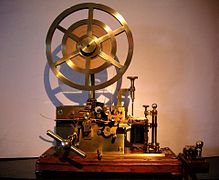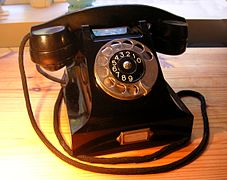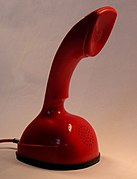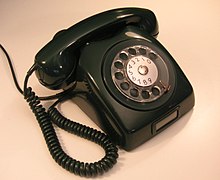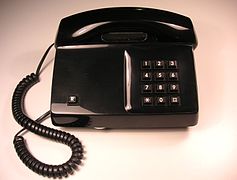Ericsson
| Telefonaktiebolaget LM Ericsson
|
|
|---|---|
| legal form | Aktiebolag |
| ISIN |
SE0000108649 (A) SE0000108656 (B) |
| founding | 1876 |
| Seat | Stockholm , Sweden |
| management | Börje Ekholm, President and CEO Ronnie Leten , Chairman of the Board |
| Number of employees | 109,127 (2017) |
| sales | 223 billion SEK (2016) |
| Website | www.ericsson.com |
Telefonaktiebolaget LM Ericsson (Ericsson) is a Swedish company based in Stockholm . Cellular technology , internet and multimedia communication and telecommunication form the core business . Developments in these areas are primarily aimed at companies, network operators and service providers. Up until February 15, 2012, Ericsson was also represented in the private customer market in the mobile phone segment with the joint venture Sony Ericsson .
The company was founded in 1876 by Lars Magnus Ericsson . Ericsson is active in more than 180 countries and employs more than 109,000 people.
Business activity

Ericsson supplies network operators and service providers with mobile and broadband "end-to-end" solutions. The company supplies these solutions for all existing mobile networks (including GSM (2G) and UMTS (3G) systems) as well as broadband multiservice networks and network access. The portfolio includes technology and business consulting, network infrastructure, multimedia and internet technologies as well as terminal platforms, multimedia applications and various services.
Ericsson’s customers include the ten largest mobile network operators in the world; More than 40 percent of all mobile phone calls are made over Ericsson networks.
In 2008 Ericsson had a total of 208 billion Swedish kronor (around 20 billion euros). The Sony Ericsson joint venture , in which Ericsson had a 50 percent share, had an annual turnover of 13 billion euros. However, Sony bought the shares from Ericsson for 1.05 billion euros, so that the joint venture dissolved in 2012.
The company divides its business into three business areas:
The Networks business segment includes the creation and construction of the networks that enable access to the transmission of information. The services for commissioning the network infrastructure are included. It contributes 69 percent to total sales. The largest market is Asia-Pacific with 33 percent. 22 percent of sales are generated in Western Europe. Central and Eastern Europe, including the Middle East and Africa, contribute 28 percent, Latin America 10 percent, and North America 7 percent.
The Professional Services business segment comprises the range of services related to strategic planning, construction and operation of telecommunications facilities. Ericsson offers a range of managed services which, in addition to operating a wide variety of networks and the ability to request network capacities as required, also includes hosting applications, solutions and platforms. Furthermore, services in customer support, system integration, advice and training are offered. The segment contributes 23 percent to total sales, of which 41 percent come from Western Europe, Central and Eastern Europe, the Middle East and Africa 19 percent, Asia-Pacific 21 percent, Latin America 10 percent, North America 9 percent.
In the multimedia business segment , the company sells internet-based applications in order to create multimedia content for mobile and landline applications and to process it on the end devices. The division contributes 8 percent to total sales and is primarily generated in Western Europe (46 percent), Central and Eastern Europe, the Middle East and Africa (25 percent), and Asia-Pacific (15 percent), Latin and North America each contribute 7 percent Percent at.
At the beginning of 2009, Ericsson and STMicroelectronics merged their semiconductor divisions for mobile radio terminals in the joint venture ST-Ericsson . This was dissolved again in 2013.
Ericsson in Germany
At the time of the telecommunications monopoly, sales of Ericsson products to Germany were not very extensive, as the Deutsche Reichspost and later the Deutsche Bundespost, due to their monopoly position, mainly awarded the orders to Siemens . Ericsson only achieved a breakthrough with the advent of mobile telephony: while DeTeMobil's D1 network went to Siemens, Alcatel, Lucent and Motorola, Ericsson was able to qualify for the expansion of Mannesmann Mobilfunk's D2 network in 1990 .
Ericsson has been present in Germany since 1950. In 1955 the company settled in Düsseldorf , where Ericsson’s headquarters are still located in Germany today. In addition, a research and development center in Herzogenrath has been part of the group since 1991 ; this in turn had a branch in neighboring Aachen until the end of 2010 . The Nuremberg Prototype Unit was added in 2005 and another large location in Backnang near Stuttgart was added in 2006 through the takeover of the competitor Marconi Corporation plc .
Only one and a half years after the takeover of Marconi, however, the management of Ericsson announced that they would partially outsource the Backnang location and possibly downsize it. After massive protests by employees, the Ericsson Group initially announced in September 2007 that it would convert its Backnang location into an independent research and development center.
In March 2008, however, Ericsson announced the decision to close the Backnang site. The development is to be closed, the sales are to be relocated to another location in the Stuttgart area to a reduced extent. One of the few products that Ericsson wants to receive at the Backnang site is the "ServiceOn" network management system.
During the general downturn in the telecommunications industry shortly after the turn of the millennium, the R&D branches in Hildesheim and Nuremberg were closed as part of consolidation measures. The Nuremberg location was reopened in autumn 2005 and at the end of 2008 employed over 250 people. From 2009 to 2013 the Nuremberg location was part of the ST-Ericsson joint venture . After STMicroelectronics left the joint venture, Ericsson took over the Nuremberg location again in August 2013 as part of the independent modems division. In September 2014, the group finally announced the renewed closure of the Nuremberg location.
In July 2007, Ericsson took over the Frankfurt-based software manufacturer LHS Telekommunikation , which at that time employed around 1000 people worldwide, including around 400 in Germany. LHS 'main product is BSCS , a customer administration and billing system for cell phone operators. On January 5, 2011, LHS was renamed Ericsson Telekommunikation GmbH & Co. KG , from which the customer service and sales area was spun off in 2010 and incorporated into Ericsson GmbH Düsseldorf.
The Rosenheim-based company Kathrein , at times the world market leader in antenna technology, sold its division for the development and production of mobile communications antennas to Ericsson in February 2019. With the purchase, the Swedish group is preparing for the start of the new 5G mobile technology .
Ericsson Austria
Ericsson Austria emerged from the telecommunications company Deckert & Homolka , which was founded in Vienna in 1872 and produced in Kindberg in Styria. In 1908, when Deckert & Homolka entered into a cooperation with Ericsson, the company already employed around 1,000 people. The company Ericsson Österreich Elektrizitäts AG emerged from this cooperation in 1911 . Eduard Schrack acquired shares in the company in 1939 . In the years 1948 to 1978 this company was again independent as Schrack AG . In 1978 the collaboration with Ericsson began again under Eduard Harald Schrack , Schrack's son. In the years 1991 to 1997 Ericsson took over Schrack Electronics, as it was called from 1980, almost 100%. In 1994 the security and communication systems division was spun off and sold as an independent company under the name Schrack Seconet . Likewise, the part that was first sold to Rexel , which today is again working independently as Schrack Technik . The company has been operating under the name Ericsson Austria since 1996.
In 2007 Ericsson Austria achieved sales of 102 million euros in Austria with 88 employees. The company is based in Vienna.
history
A fire at a supplier in Albuquerque, New Mexico in 2000, forced Ericsson to give up its mobile phone division. After the fire, the company reacted too slowly and - unlike its competitor Nokia - was unable to access alternative suppliers. The losses of several hundred million US dollars were partially covered by insurance. This resulted in a record sum insured in 2001 - apart from the attacks on September 11th. The creation of Sony Ericsson is seen as a consequence of the fire.
Picture gallery
Some classic Ericsson products:
Ericsson's skeleton telephone from 1892, also called Taxen (the dachshund)
Ericsson's Ericofon , called Cobra , 1956
Ericssons Dialog , (developed together with Televerket ), Swedish standard telephone from 1962
Ericsson's first push-button telephone Diavox , (developed together with Televerket ), Swedish standard telephone from 1978
See also
literature
- John Meurling, Richard Jeans: The Ericsson Chronicle: 125 Years in Telecommunications . Informationsförlaget, Stockholm 2000, ISBN 91-7736-464-3 . Company chronicle for the 125th anniversary
- John Meurling, Richard Jeans: The Mobile Phone Book. The Invention of the Mobile Telephone Industry . London 1994, ISBN 0-9524031-0-2 . The emergence of the cellular industry from Ericsson's perspective
Web links
Individual evidence
- ↑ a b ericsson.com: Company Facts
- ↑ ericsson.com: Annual Report 2016
- ↑ Archived copy ( memento of the original from February 19, 2012 in the Internet Archive ) Info: The archive link was inserted automatically and has not yet been checked. Please check the original and archive link according to the instructions and then remove this notice.
- ^ Sony Ericsson Mobile Communications established today. In: CisionWire News Releases. October 1, 2001, accessed November 28, 2015 .
- ↑ Ericsson´s Vision ( Memento of the original from September 19, 2008 in the Internet Archive ) Info: The archive link was inserted automatically and has not yet been checked. Please check the original and archive link according to the instructions and then remove this notice. Ericsson Germany website
- ↑ Company facts ( Memento of the original from November 18, 2008 in the Internet Archive ) Info: The archive link was inserted automatically and has not yet been checked. Please check the original and archive link according to the instructions and then remove this notice. Ericsson Germany website
- ↑ Press release (inaccessible) Sony Ericsson website
- ↑ Annual Report 2007 ( Memento of the original dated August 8, 2008 in the Internet Archive ) Info: The archive link was inserted automatically and has not yet been checked. Please check the original and archive link according to the instructions and then remove this notice.
- ↑ Ericsson Managed Services ( Memento of the original from September 19, 2008 in the Internet Archive ) Info: The archive link was inserted automatically and has not yet been checked. Please check the original and archive link according to the instructions and then remove this notice. Ericsson Germany website
- ↑ Failed cooperation: Ericsson and STMicro dissolve joint venture . Handelsblatt . March 18, 2013. Retrieved January 23, 2014.
- ↑ Stuttgarter Nachrichten : Backnang is threatened with bloodletting again - management wants to outsource some of the Ericsson businesses. ( Page no longer available , search in web archives ) Info: The link was automatically marked as defective. Please check the link according to the instructions and then remove this notice. (June 5, 2007)
- ↑ Backnang Kreiszeitung : Ericsson strengthens the Backnang location ( page no longer available , search in web archives ) Info: The link was automatically marked as defective. Please check the link according to the instructions and then remove this notice. (September 26, 2007)
- ↑ Ericsson: Ericsson keeps R&D at the Backnang location ( page can no longer be accessed , search in web archives ) Info: The link was automatically marked as defective. Please check the link according to the instructions and then remove this notice. (September 25, 2007)
- ↑ Backnanger Kreiszeitung : Ericsson wants to close its location in Backnang ( page no longer available , search in web archives ) Info: The link was automatically marked as defective. Please check the link according to the instructions and then remove this notice. (March 12, 2008)
- ↑ Backnanger Kreiszeitung : Of more than 600 employees, around 215 remain ( page can no longer be accessed , search in web archives ) Info: The link was automatically marked as defective. Please check the link according to the instructions and then remove this notice. (March 13, 2008)
- ↑ Heise Ticker: Ericsson outsources development in Backnang (June 27, 2007)
- ↑ Ericsson: Ericsson and STMicroelectronics complete transaction to split up ST-Ericsson (August 5, 2013)
- ↑ Ericsson: Ericsson stops fashion development for smartphones (September 18, 2014)
- ↑ Antenna manufacturer Kathrein sells core business to Ericsson , Bayerischer Rundfunk, published and accessed February 25, 2019
- ↑ a b Entry on Ericsson in the Austria Forum (in the AEIOU Austria Lexicon )
- ↑ Date & Facts ( page no longer available , search in web archives ) Info: The link was automatically marked as defective. Please check the link according to the instructions and then remove this notice. Retrieved September 16, 2010 from Schreack Seconet
- ↑ Top1001.at ( Memento of the original from November 16, 2011 in the Internet Archive ) Info: The archive link was automatically inserted and not yet checked. Please check the original and archive link according to the instructions and then remove this notice. Retrieved September 16, 2010
- ↑ Amit S. Mukherjee (2008): The Spider's Strategy. P. 3 ff.




